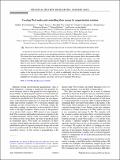| dc.contributor.author | Ghimire, Madhav Prasad | |
| dc.contributor.author | Facio, Jorge I | |
| dc.contributor.author | You, Jhih-Shih | |
| dc.contributor.author | Ye, Linda | |
| dc.contributor.author | Checkelsky, Joseph | |
| dc.contributor.author | Fang, Shiang | |
| dc.contributor.author | Kaxiras, Efthimios | |
| dc.contributor.author | Richter, Manuel | |
| dc.contributor.author | van den Brink, Jeroen | |
| dc.date.accessioned | 2020-10-05T22:01:46Z | |
| dc.date.available | 2020-10-05T22:01:46Z | |
| dc.date.issued | 2019-12 | |
| dc.date.submitted | 2019-10 | |
| dc.identifier.issn | 2643-1564 | |
| dc.identifier.uri | https://hdl.handle.net/1721.1/127813 | |
| dc.description.abstract | As they do not rely on the presence of any crystal symmetry, Weyl nodes are robust topological features of an electronic structure that can occur at any momentum and energy. Acting as sinks and sources of Berry curvature, Weyl nodes have been predicted to strongly affect the transverse electronic response, like in the anomalous Hall or Nernst effects. However, to observe large anomalous effects the Weyl nodes need to be close to or at the Fermi level, which implies the band structure must be tuned by an external parameter, e.g., chemical doping. Here we show that in a ferromagnetic metal tuning of the Weyl node energy and momentum can be achieved by rotation of the magnetization. First, taking as example the elementary magnet hcp-Co, we use electronic structure calculations based on density-functional theory to show that by canting the magnetization away from the easy axis, Weyl nodes can be driven exactly to the Fermi surface. Second, we show that the same phenomenology applies to the kagome ferromagnet Co₃Sn₂S₂, in which we additionally show how the dynamics in energy and momentum of the Weyl nodes affects the calculated anomalous Hall and Nernst conductivities. Our results highlight how the intrinsic magnetic anisotropy can be used to engineer Weyl physics. | en_US |
| dc.description.sponsorship | Gordon and Betty Moore Foundation (Grant GBMF3848) | en_US |
| dc.description.sponsorship | United States—Israel Binational Science Foundation (Grant 2016389) | en_US |
| dc.language.iso | en | |
| dc.publisher | American Physical Society (APS) | en_US |
| dc.relation.isversionof | http://dx.doi.org/10.1103/PHYSREVRESEARCH.1.032044 | en_US |
| dc.rights | Creative Commons Attribution 4.0 International license | en_US |
| dc.rights.uri | https://creativecommons.org/licenses/by/4.0/ | en_US |
| dc.source | APS | en_US |
| dc.title | Creating Weyl nodes and controlling their energy by magnetization rotation | en_US |
| dc.type | Article | en_US |
| dc.identifier.citation | Ghimire, Madhav Prasad et al. "Creating Weyl nodes and controlling their energy by magnetization rotation." Physical Review Research 1, 3 (December 2019): 032044(R) | en_US |
| dc.contributor.department | Massachusetts Institute of Technology. Department of Physics | en_US |
| dc.relation.journal | Physical Review Research | en_US |
| dc.eprint.version | Final published version | en_US |
| dc.type.uri | http://purl.org/eprint/type/JournalArticle | en_US |
| eprint.status | http://purl.org/eprint/status/PeerReviewed | en_US |
| dc.date.updated | 2020-09-22T17:33:21Z | |
| dspace.orderedauthors | Ghimire, MP; Facio, JI; You, J-S; Ye, L; Checkelsky, JG; Fang, S; Kaxiras, E; Richter, M; van den Brink, J | en_US |
| dspace.date.submission | 2020-09-22T17:33:27Z | |
| mit.journal.volume | 1 | en_US |
| mit.journal.issue | 3 | en_US |
| mit.license | PUBLISHER_CC | |
| mit.metadata.status | Complete | |
